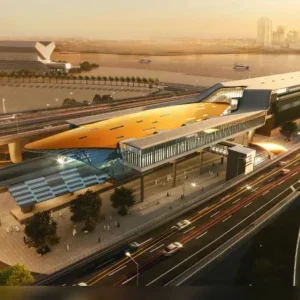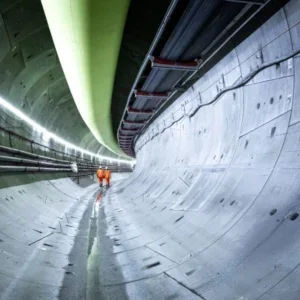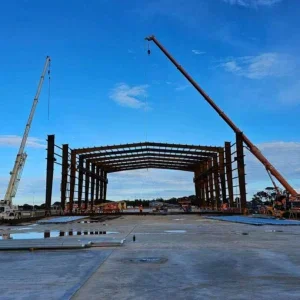
The upgrades at Schoharie Reservoir include three central projects. The first major project, a full-scale rehabilitation of Gilboa Dam, was completed in 2014. DEP is currently working on the other two largest components of the program, a low-level outlet that will be capable of releasing water downstream from Schoharie Reservoir into the Schoharie Creek, and a full rehabilitation of the Shandaken Tunnel Intake Chamber, which conveys drinking water from the reservoir into an 18-mile tunnel on its way to Ashokan Reservoir in Ulster County.
In October, excavation began on the water leg of the tunnel, which stretches approximately 930ft from the gate shaft to an intake structure at the bottom of Schoharie Reservoir, several hundred feet south of the dam. DEP expects the water leg to be finished as early as of this weekend. Once workers bore into the bottom of the reservoir, a specialized dive team will remove the micro-tunnel boring machine from the 135ft-deep water and install the remaining parts of the intake structure. Some of that work, including the removal of the micro-tunnel boring machine, will likely wait until spring when the reservoir is free of ice.
Tunnelling for the new release works is nearly complete. Tunnelling began after workers built a 182ft-deep gate shaft to serve as the starting point for both legs of the tunnel. A 9.5ft-diameter micro-tunnel boring machine began to excavate the new release tunnel in 2017. Tunnelling work included the construction of approximately 2,118 linear feet of tunnel running as deep as 185 feet below the surface.
Last May, DEP announced that it finished the land leg of the new release tunnel, which ran 1,188ft from the gate shaft near Route 990V to the location of a future valve chamber on the eastern bank of Schoharie Creek.
DEP has also made considerable progress on the $47 million rehabilitation of the Shandaken Tunnel Intake Chamber (STIC). That facility controls the flow of drinking water from Schoharie Reservoir into the Shandaken Tunnel, which travels 18 miles through the Catskills. The tunnel discharges water into the Esopus Creek, in which the water travels another 11 miles to help refill Ashokan Reservoir throughout the year.
The STIC rehabilitation project includes replacing eight sluice gates that control the flow of water into the Shandaken Tunnel by opening and closing large waterways. The gates within the intake structure were installed during the 1920s when the reservoir was built. Three of the gates are currently stuck because they broke off their lifting mechanisms and became wedged in place. Last year, skilled divers descended about 130 feet into the gate shaft and used sonar equipment to take precise measurements of the gates and the grooves that guide them. Those measurements are being used to fabricate new gates, lifting mechanisms and other infrastructure to restore the full function of the intake chamber.
Work on that effort will continue in 2019. The Shandaken Tunnel will be shut down from March 1–April 30 this year while workers install a plug and bypass system within the intake structure. The approximately 8-foot-diameter plug will block the flow of water into the Shandaken Tunnel and prevent divers from being pulled into the tunnel while they remove and replace the old gates. The bypass system—which includes a pipe that runs through the plug—will allow DEP to safely move up to 100 million gallons of water each day into the tunnel without harming the divers or their work.
DEP will replace the sluice gates once the plug is installed. That work will take approximately two years, from 2019-2021. DEP’s ability to move water from Schoharie Reservoir into the Esopus Creek will be limited during that time. While the gravity-fed bypass pipe can convey up to 100 million gallons of water each day, its capacity at any given time will depend upon reservoir elevation.
A portion of the limited-capacity bypass system will be left in place and modified after the rehabilitation of the Shandaken Tunnel Intake Chamber is finished. The pipe will be connected to an articulating arm, which can pivot 45 feet up and down, giving DEP the ability to draw water from multiple depths within Schoharie Reservoir for the first time. The current intake structure only draws water from the bottom of the reservoir. In the future, this intake will help DEP convey higher quality water from Schoharie Reservoir and extend the life of its cold-water bank that supports the trout fishery on the Esopus Creek. Workers last year cored a 5-foot-diameter cylinder through the outer wall of the intake chamber in preparation for the bypass pipe. Additional cores will be drilled through the shaft wall this year to allow for the installation of the bypass pipe, its control valves and other components.
Work on those projects began in 2005 and is expected to be finished in 2022.







